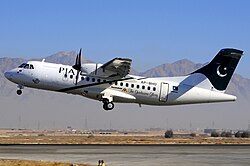The article's lead section may need to be rewritten. The reason given is: parts of the lead mention excessively how unusual the circumstances of the accident were, without actually explaining the exact causes. (May 2024) |
 AP-BHO, the aircraft involved in the accident, in 2011 | |
| Accident | |
|---|---|
| Date | 7 December 2016 |
| Summary | Loss of control due to maintenance error |
| Site | Near Havelian, Pakistan 34°0.355′N 73°10.676′E / 34.005917°N 73.177933°E |
| Aircraft | |
| Aircraft type | ATR 42-500 |
| Aircraft name | Hasanabdal |
| Operator | Pakistan International Airlines |
| IATA flight No. | PK661 |
| ICAO flight No. | PIA661 |
| Call sign | PAKISTAN 661 |
| Registration | AP-BHO |
| Flight origin | Chitral Airport, Chitral, Pakistan |
| Destination | Benazir Bhutto International Airport, Islamabad, Pakistan |
| Occupants | 47 |
| Passengers | 42 |
| Crew | 5 |
| Fatalities | 47 |
| Survivors | 0 |
Pakistan International Airlines Flight 661 was a Pakistani domestic passenger flight from Chitral to Islamabad, operated by Pakistan's flag carrier Pakistan International Airlines. On 7 December 2016, the aircraft serving the route, an ATR 42-500 twin-turboprop, crashed near Havelian following an engine failure.[1][2][3] All 47 people on board died, including singer-turned-preacher and entrepreneur Junaid Jamshed,[4] and the Deputy Commissioner of the District of Chitral.[5]
Four years after the crash, Pakistan Aircraft Accident Investigation Board (AAIB) published the result of their investigation. In the final report, the crash was described as a unique case and the first ever of its kind in the entire operational life of ATR aircraft. A series of very unusual technical failures led to the sudden appearance of huge amount of drag on the left side. The bizarre nature of the emergency that the crew faced eventually caused them to lose control. The investigation further revealed that faulty maintenance practices within PIA were to blame for such failures and the issue had been allowed to happen by weak oversight from the company and the nation's aviation regulatory body.[6]: XI–XXXVI
The complex nature of the crash led to the issuance of several recommendations, two of which were urgent enough that mentioned parties were asked to comply immediately. Following the discovery of loopholes within CAA oversight, AAIB ordered authorities to impose stricter monitoring regarding airworthiness and airliner operation in the country. Pakistan's CRM training system was asked to be revamped. While extremely remote, there were also fears from the investigators about the possibility of another similar crash in the future. The manufacturer of the aircraft, ATR, was asked to include a specific procedure to safely recover from the situation.[6]: 156–158
- ^ "Pakistan International Airways flight 'crashes in north'". BBC News. 7 December 2016. Retrieved 7 December 2016.
- ^ "Pakistani plane with more than 40 people aboard crashes in north: police". Reuters. 7 December 2016. Retrieved 7 December 2016.
- ^ "Flight PK661 Incident" (Press release). Pakistan International Airlines. 7 December 2016. Retrieved 7 December 2016.
42 (Male:31, Female:09, Infant:02) Including 02 Austrians and 01 Chinese
- ^ "PIA Crash: All 47 Aboard Reported Dead, Blackbox Recovered". The Quint. 8 December 2016. Retrieved 7 December 2016.
- ^ "PIA plane crash: All 47 on board killed; Pakistani pop star among victims". CNN. 7 December 2016. Retrieved 8 December 2016.
- ^ a b "FINAL INVESTIGATION REPORT INTO ACCIDENT OF PIA FLIGHT PK-661 ATR42-500 REG NO AP-BHO CRASHED NEAR HAVELLIAN ON 07-12-2016" (PDF). Aircraft Accident Investigation Board of Pakistan, Pakistan Civil Aviation Authority. 18 November 2020. Retrieved 18 November 2020.